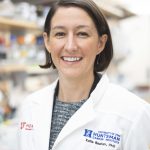Cancer is a problem of uncontrolled cell growth. Either too many new cells are being born or not enough old cells are dying. Cellular senescence is a normal aging process in which cells stop growing. However, these cells remain metabolically active and secrete factors to attract immune cells and increase inflammation. This process occurs naturally during aging due to different types of stress that build up over time. Senescence was first thought to protect against cancer since it prevents new cells from being made. In fact, many drugs currently used to treat human cancer patients block tumor growth by turning on senescence. However, more recent studies have shown that some tumor cells can eventually escape this process and start growing again. Cells that exit senescence may even grow faster and spread more easily than before. Given these new findings about the ‘dark side’ of senescence, there has been growing interest in using anti-aging drugs to treat cancer. However, this process is complex and has been difficult to study in the lab. We created a new mouse model of adrenocortical carcinoma (ACC), which is a deadly cancer that starts in the adrenal gland and has no effective treatments. Our model develops adrenal cancer, but only after an extended period of senescence. This model provides a unique opportunity to study the relationship between aging and cancer. Using this system, our goal is to (1) study the long-term effects of senescence on tumor growth, and (2) test anti-aging drugs as cancer therapy.
Year: 2021
Daniel Pollyea, MD
Funded by Lloyd Family Clinical Scholar Fund
Myeloid malignancies (myelodysplastic syndrome [MDS] and acute myeloid leukemia [AML]) are very aggressive blood cancers that have limited treatment options. We have learned that these cancers have “stem cell” populations, which allow the disease to propagate, and are the source of relapse when it occurs. One cannot hope to cure these diseases without eradicating the stem cells, but that has historically been very difficult because so little was known about this cell population. We have recently made some breakthrough discoveries related to these stem cells; they have weaknesses that distinguish them from other cell populations in the body, and those weaknesses, which relate to unique ways in which these cells choose to metabolize energy, can be exploited or targeted with particular therapies. Our project seeks to test the theory that specifically targeting metabolic weaknesses in stem cell populations can lead to deep and durable responses for patients with myeloid malignancies. These discoveries will help us to learn how these diseases can ultimately be cured, and will set the stage for the necessary clinical trials that will be designed to do just that.
Akash Patnaik, MD, PhD, MMSc
Funded in honor of Tony Kozy by the Maui Hui
Immune-based medicines are effective in treating and curing subsets of patients across multiple cancers. However, approximately 80% of patients across all cancers fail to respond to immune-based medicines. This lack of clinical benefit is particularly prevalent in aggressive forms of metastatic prostate cancer (MPC) that are resistant to hormonal therapies, where few objective responses to immune-based medicines have been observed.
The immune system is comprised of cells that can both promote and suppress the growth of the cancer. Our research has revealed that the microenvironment within MPC exhibits scarcity of immune cells. Furthermore, the sparse immune cells that reside within the microenvironment of MPC promote tumor growth and progression. Therefore, there is an urgent need to develop medicines that reprogram the tumor-promoting “bad” immune cells to create a more favorable environment, so the “good” immune cells can enter the tumor and kill cancer cells. The goal of our research is to identify and develop new medicines that can achieve this “switch” in the immune system, to enhance recognition and elimination of the most aggressive forms of prostate cancer. We will test these potential medicines in both mouse models of PC in the laboratory, and in patients with the most aggressive forms of MPC enrolled in clinical trials. Collectively, the findings stemming from this proposal will lead to a deeper understanding of the immune escape mechanisms that allow MPC to spread, and advance the clinical development of novel medicines to reinvigorate the body’s immune system to eradicate MPC.
David Masopust, PhD
This new drug, called peptide alarm therapy (PAT), is injected directly into a tumor to stimulate immune cells to attack the tumor. This drug stimulates immune responses that people already have because of exposure to viral infections and/or vaccines. We found that, in mice, injection of this drug in combination with a PD-L1 inhibitor, a drug already approved by the FDA, eliminates tumors. This new drug can be used for different types of solid tumors and is expected to have few side effects. This is a first clinical trial of this new type of drug to determine if it is safe. This new type of drug may be effective against many different tumor types in adult or pediatric patients.
Adrian Krainer, PhD
Funded by the Dick Vitale Pediatric Cancer Research Fund
We aim to develop a novel and effective therapy for a lethal pediatric brain cancer (diffuse midline glioma, DMG). No effective treatment for DMG currently exists. This cancer arises when a mutation appears in a gene called H3F3A, causing it to produce a toxic protein. The mutant protein makes cells grow unchecked, forming a tumor in an inaccessible brain region and eventually killing the patient. Each of our genes makes RNA—so-called messenger RNA (mRNA)—and the mRNA is then read in another part of the cell to make the protein encoded by that gene. The technology we use, called “antisense”, allows us to target the mRNA made from a gene, and either destroy it or change it. Either way, the toxic protein is no longer made, and because the tumor cells require it for growth, they stop growing and die or change into normal cells. Once our antisense drug is developed, it will be injected into the fluid surrounding the spinal cord, allowing it to reach the brain tumor. Another gene, called H3F3B, encodes the same protein as H3F3A, so our method will get rid of the defective protein but not the normal protein. Therefore, the drug should not harm normal tissues outside the tumor. We will design, test, and perfect our antisense approach using cells derived from DMG tumors, and mouse models of this brain cancer. If this project is successful, the resulting antisense drug will undergo further safety tests, in preparation for clinical trials involving DMG patients.
Jun Wang, PhD
Funded by the Wine Celebration in honor of Carol Bornstein
Tumors are constantly growing and mutating – they are different from healthy cells, and thus should be able to be recognized by your immune system. However, immune cells respond to molecules that act as brakes, which can be used by tumor cells to escape being killed. While some of these immune brakes have been discovered, drugs blocking these do not work in most cancer patients, and many remain unknown. To improve survival for everyone, we need to figure out what the other important brakes are so we can reprogram your own immune system to fight cancer. We have recently discovered Siglec-15 as a new immune cell brake in tumors. Blocking Siglec-15 shows improved immune activity in studies involving human cells and mice. Based on these results, clinical trials targeting Siglec-15 are currently ongoing. Initial trial results show that targeting Siglec-15 is safe and slows down tumor growth in patients who have already failed other therapies. Thus, we need to understand the biology of Siglec-15 so we can design the best cancer therapy possible. Here, we will study how Siglec-15 suppresses tumor immunity and identify strategies to maximize its clinical response. Our proposal will improve our knowledge of cancer immunology and help patients in the fight against late-stage cancers.
Andrew Volk, PhD
Funded by the Constellation Gold Network Distributors in honor of the Dick Vitale Pediatric Cancer Research Fund
Acute myeloid leukemia is a cancer of the blood that affects hundreds of children each year in the USA. While the survival rate has improved, there is still a 30-35% chance of relapse within five years of diagnosis. We need better therapeutic options to treat this disease. Leukemia, in most cases, is caused by a breakdown in the blood cells’ ability to regulate their genes. This leads to uncontrolled growth of partially developed blood cells that can overrun the host. While there are some drugs available to treat this disease, most patients eventually will see their leukemia return. Our research goal is to understand the mechanisms that break down when a healthy cell becomes a leukemic cell. We want to develop better therapeutics to treat leukemia. We have found that excessive levels of the chromatin assembly gene CHAF1B is needed for leukemic cells to stay cancerous. Turning down CHAF1B is enough to turn the leukemia tumor into normal cells. In fact, we think that CHAF1B is responsible for driving therapy resistance in AML by repressing expression of differentiation genes. Our work over the next two years will enhance our understanding of how this process breaks down in leukemia, and hopefully lead to better treatment options for patients.
Andrew Venteicher, MD, PhD
Abeloff V Scholar * (Tie for Top Rank)
Cancers of the brain and spine are hard to cure and are often lethal. Knowing if and when a cancer will recur has been challenging to predict. We do not have a good test to determine which cancers will return quickly and which will not. For this reason, nearly all patients are given the same treatment that often involves surgery, radiation, and drug therapy.
A holy grail in cancer research is to create a test that can predict cancer behavior. Our laboratory studies DNA structure and how it can be used to predict cancer behavior. One goal of our laboratory is to create a test based on DNA structure that can pick out the aggressive brain cancers from the less aggressive ones. A second goal is to create a test that can tell which cancers might respond to new drug treatments. To do this, we use a combination of cutting-edge experimental and computational approaches. We anticipate that such research will lead to the ability to create a treatment plan for each patient individually. We can treat aggressive cancers with tailored plans, whereas we can hold on treatments for cancers that are unlikely to need it.
Amy Lee, PhD
Cancer occurs when cells grow in an uncontrolled manner. These cells spread to other tissues and form metastatic tumors. Unlike normal cells, cancer cells can survive within a tumor environment that has low amounts of nutrients and does not have a normal oxygen supply. This is because cancer cells contain a different set of factors called “proteins,” which are the principal machinery for work in a cell. These changes in protein are what drive increased cell growth. Proteins are made through a process called “translation,” where the cellular genetic material is converted from RNA into protein. We seek to block the translation of cancer-promoting proteins, and to determine if this will stop the formation of tumors.
To address this goal, our research is focused on understanding how translation is regulated in cancer cells. Here, we are studying a regulator of translation called eIF3. eIF3 is increased in cancers, including those of the breast, lung, stomach, cervix, and prostate. Furthermore, eIF3 overexpression is linked to poor prognosis. In this proposal, we will determine how eIF3 contributes to translation of cancer-promoting proteins and evaluate the potential of eIF3 as a therapeutic target. Ultimately, the long-term goal of this research is to define how protein production is regulated in cancer cells, to allow for rational design of cancer treatment therapeutics that target translation.
Jeffrey Ishizuka, MD, DPhil
One of the biggest advances in cancer therapy in the past century has been the recognition that the immune system can be targeted by drugs to trigger immunity against tumors. These drugs, called ‘immunotherapies’ have improved survival for patients in a large and growing number of cancers. However, across cancer types, most patients do not durably benefit from treatment. The reasons for this lack of benefit in particular tumor types and patient populations are unclear. We have developed an approach that leverages new technologies that give us insight into the states and activities of individual tumor and immune cells directly isolated from patient tumors. This approach allows us to dissect mechanisms of resistance to immunotherapy and cellular responses to novel treatments. We are applying our strategy in head and neck cancers, an under‐studied class of tumors that is diagnosed in more than 60,000 people in the US each year. Our preliminary studies have identified distinct immune suppressive pathways enriched in head and neck cancer. In the present project we will test whether drugs aimed at targeting these pathways can restore the anti‐tumor activation of immune cells. If successful, these studies aim to: i) validate the use of novel combination immunotherapies for head and neck cancer and ii) identify biomarkers of response that will allow us to select the patients who will most benefit from these combinations.














